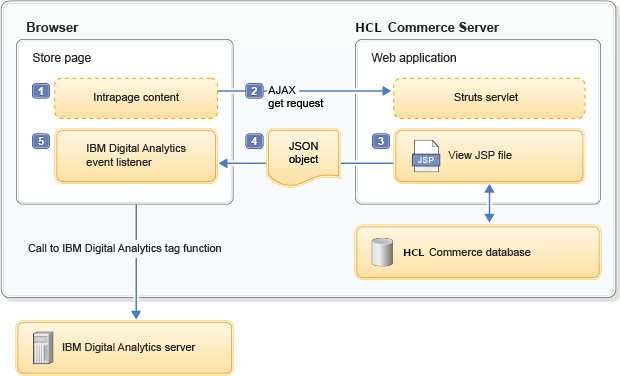Digital Analytics integration with Web 2.0 starter stores
The HCL Commerce Web 2.0 starter stores use Rich Internet Application (RIA) technologies such as Ajax (Asynchronous JavaScript and XML) and Dojo widgets. With these technologies certain customer interactions with store page content do not result in a full page refresh. provides a framework to track these page interactions, in addition to interactions that result in a full-page refresh. This framework ensures that IBM Digital Analytics collects accurate analytics data about how customers are using your Web 2.0 store.
Integration with IBM Digital Analytics
The HCL Commerce Aurora B2C and B2B starter stores contain code in their JSP pages to track both full-page and page interactions.How analytics data is captured in Web 2.0 stores
Web 2.0 starter stores capture analytics data differently depending on the type of customer interaction that is being tracked:| Interaction | Description |
|---|---|
| Full-page interactions | To track interactions that cause a full-page refresh, the store pages contain
HCL Commerce analytics tags. These tags are placed at the bottom of each JSP page. When
the full page refreshes, the HCL Commerce analytics tag generates a corresponding IBM Digital Analytics data tag that contains the analytics data to provide to the IBM Digital Analytics server. For example:
|
| page interactions For IBM Digital Analytics integration, these interactions are called IBM Digital Analytics events. |
To track the interactions that do not cause a full-page refresh, the store JSP
pages contain business logic to communicate data about these events to IBM Digital Analytics. When the interaction occurs, the controller or widget for the page content generates an event.
The IBM Digital Analytics event listener detects the event and gathers relevant analytics
data about the event. Then, the IBM Digital Analytics event listener calls the
corresponding IBM Digital Analytics JavaScript function to provide the analytics data to
the IBM Digital Analytics server. For example:
|
How page interactions are tracked in a Web 2.0 store
The following diagram shows the process for tracking page interactions and how the analytics data is communicated to IBM Digital Analytics:
The tracking process unfolds like the following process:
- 1 A customer interacts with page content that does not cause a full page refresh. For example, the customer interacts with the mini shopping cart, the Product Fast Finder, or a wish list. Each of these page interactions is a tracked analytics event, and the store page contains the business logic that is required to report on the event.
- 2 The store page makes an Ajax get request. The request calls the
HCL Commerce server to get a view that corresponds to the type of interaction, for
example, the
AnalyticsProductVieworAnalyticsCartView. These views are defined in the struts configuration file for the site, and each view points to a corresponding view JSP file. - 3 The view JSP file retrieves the related analytics data from the HCL Commerce database and creates a JSON object that contains the data.
- 4 The view JSP file returns the JSON object to the store page.
- 5 The IBM Digital Analytics event listener detects the
event and gathers the analytics data from the JSON object. The IBM Digital Analytics event
listener then calls the corresponding IBM Digital Analytics tag function, for example, the
cmCreateProductViewTagorcmCreateCartViewTagfunction. The tag functions send the analytics data to the IBM Digital Analytics server.
The subtopics in this section focus on understanding and customizing the framework that tracks page interactions. For more information about the HCL Commerce analytics tags, see Analytics tag library for HCL Commerce.